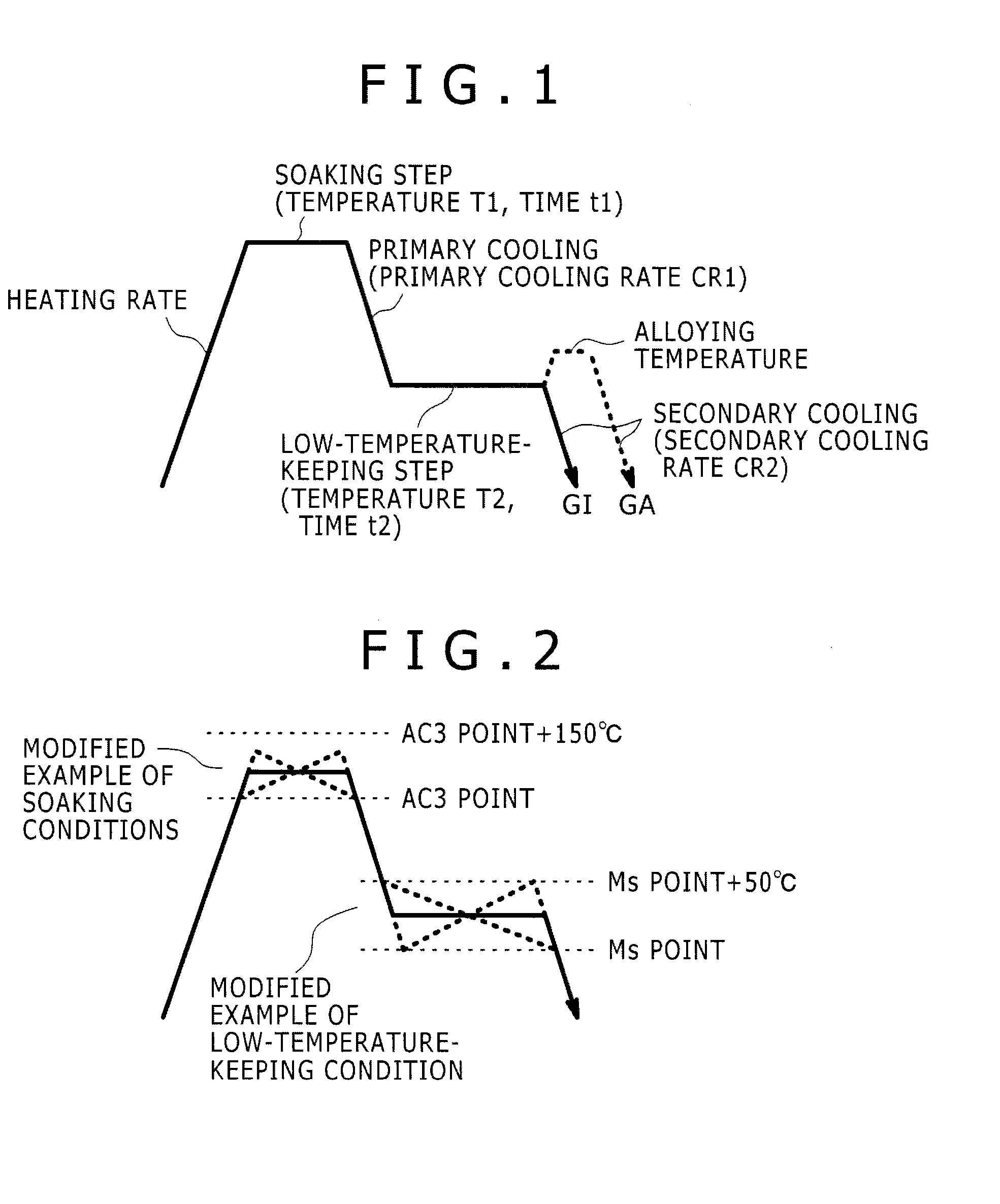High-yield-ratio and high-strength steel sheet excellent in workability
a high-strength steel and workability technology, applied in the field of high-strength steel sheets, can solve the problems of inability to achieve the compatibility between high-strength steel and workability, publication never discloses a steel sheet having both high-strength steel and excellent workability, and reduces the spot-weldability or the adhesiveness of plating, so as to ensure the workability and spot-weldability, and reduce the toughness and du
- Summary
- Abstract
- Description
- Claims
- Application Information
AI Technical Summary
Benefits of technology
Problems solved by technology
Method used
Image
Examples
example 1
Including Working Examples and Comparative Examples
[0066]Respective ingots of steels having various chemical compositions shown in Table 1 were manufactured, and the ingots were each hot-rolled into a thickness of 2.4 mm. At the time, the finish rolling temperature and the rolling temperature were set to 880° C. and 600° C., respectively. Next, the resultant hot-rolled steel sheets were washed with an acid, and then cold-rolled into a thickness of 1.2 mm (cold rolling ratio: 50%).
[0067]Next, the steel sheets were annealed in a galvanization-continued annealing line under respective annealing conditions shown in Table 2, and then manufactured into hot-dip galvanized steel sheets (GI) at a galvanizing bath temperature of 450° C., or into alloyed hot-dip galvanized steel sheets (GA) by holding the hot-dip galvanized steel sheets at 550° C. for 25 sec after the galvanizing.
[0068]For equations for calculating the Acs points and the Ms point in Table 1, reference was made to “The Physical...
example 2
[0092]In Example 1, in each of the soaking step (a) and the low-temperature-keeping step (b), the soaking or the low-temperature-keeping was conducted at a constant temperature. In present Example 2, in the steps (a) and (b), temperatures (starting temperature and finish temperature) for the soaking, and temperatures (starting temperature and finish temperature) for the low-temperature-keeping were changed as shown in Table 4.
[0093]Specifically, a hot-dip galvanized steel sheet was manufactured in the same way as in Example 1 except that the steel No. D in Table 1 satisfying the requirements of the invention was used and annealing conditions shown in Table 4 were used. Thereafter, mechanical properties thereof were measured and the structure thereof was observed in the same way as in Example 1. The results are shown in Table 5.
TABLE 4Low-temperature keepingSoaking conditionsPrimaryconditionsSecondaryExe-HeatingStartingFinishcoolingStartingFinishcoolingGalvaniza-cutionSteelratetemper...
PUM
| Property | Measurement | Unit |
|---|---|---|
| Length | aaaaa | aaaaa |
| Fraction | aaaaa | aaaaa |
| Fraction | aaaaa | aaaaa |
Abstract
Description
Claims
Application Information
 Login to View More
Login to View More - R&D
- Intellectual Property
- Life Sciences
- Materials
- Tech Scout
- Unparalleled Data Quality
- Higher Quality Content
- 60% Fewer Hallucinations
Browse by: Latest US Patents, China's latest patents, Technical Efficacy Thesaurus, Application Domain, Technology Topic, Popular Technical Reports.
© 2025 PatSnap. All rights reserved.Legal|Privacy policy|Modern Slavery Act Transparency Statement|Sitemap|About US| Contact US: help@patsnap.com

